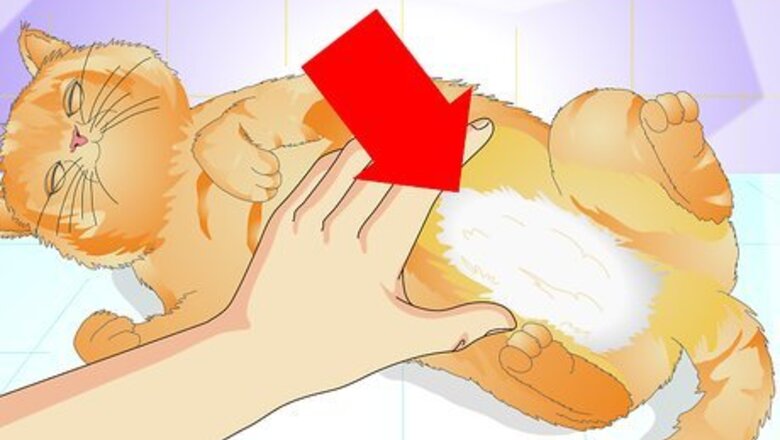
views
Note: This article applies only to female cats. If your cat is a male, refer to How to Tell if a Cat is Neutered.
Checking for Physical Signs on the Cat
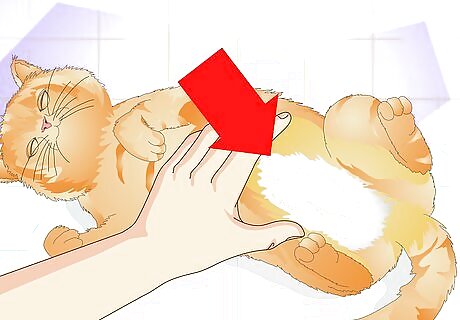
Look for shaved hair on the cat’s abdomen. Try flipping the cat onto her back so you have a clear view of her stomach. If the cat has been recently spayed, the fur on her lower abdomen area will be shorter than the fur on the rest of her body because vets have to shave this fur off before performing the operation. Note, however, that other veterinary procedures can also require patches of the cat's hair to be shaved and this is not a foolproof way to check if the cat has been splayed. Many vets spay younger cats using the flank approach. If your cat is young, also check for a square section of clipped or shaved fur over the left side of the cat's body between it's ribs and hip.

Check for a spaying scar. Hold the cat so that she's lying on her back with her stomach up. Part the fur in the lower abdomen area as best you can. Once you can see the cat's skin, check around for a scar from the operation. This may be hard to do because the tools used for spaying today typically leave a very thin scar which can fade and may be hard to see after it has healed. Usually, the scar will be a straight, thin line running lengthwise in the center of the abdomen. Also look for a scar on the left side of the cat's body between the rib and hip area. If the veterinarian used a flank approach, the scar will be in this area.
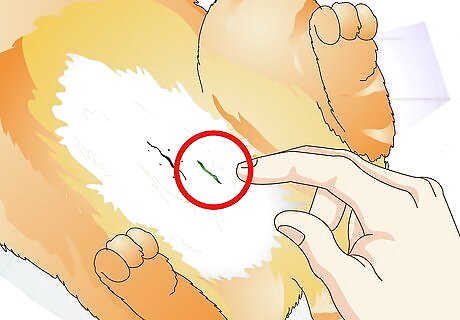
Look for tattoo markings by the incision scar or on the cat’s ear. Once a cat is spayed, a veterinarian may give her a small tattoo as an external sign that she has been spayed. Usually, this tattoo is green, drawn in the shape of a thin line, and is located on or near the scar from the incision. The tattoo should be visible when parting the hair of the abdomen, though you may need to look carefully. You'll also want to check the cat's inner ear for tattoos — this is a common site for important information to be marked on pets. In the US, a letter M means the cat has been micro chipped — almost all other tattoos mean the cat has been spayed.
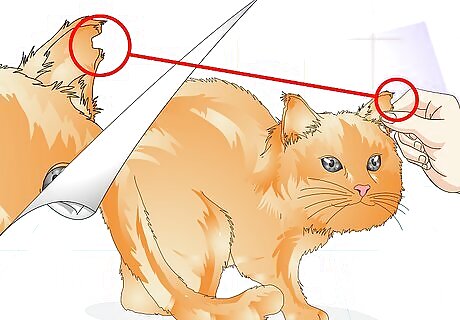
Note if the cat has a "clipped" ear. Some veterinarians and animal agencies use a practice called "ear clipping" or "ear tipping" as the universal sign of an altered feral cat — meaning it shows, in an easily recognizable way, that the feline has been spayed or neutered. This practice is utilized by many trap and release programs to limit the reproduction of feral cats thus controlling colony populations. In this case, one of the cat's ears (usually the left) has about a quarter of an inch of the tip removed — just enough to give the ear a "flat" tip. This is done while the cat is asleep from the anesthetic and heals quickly. Get a clue from ear tips. "The tip about checking for an ear tip as a sign the cat was spayed was super insightful. I never knew that a clipped ear meant the cat had been fixed! Now I can quickly ID altered ferals." - Crystal L. Confirm spay status through research. "With three rescue cats at home, I was worried about surprise litter. When I noticed one had a clipped ear, I Googled it and was relieved to learn ear tipping shows a cat was spayed. Some kind person prevented kittens from happening." - Will C. Learn when discharge indicates infection. "My kitten had some vaginal discharge, so I read up on reasons. The article said a little is normal during heat cycles, but profuse discharge means infection. I'm still taking her to the vet, but I feel better knowing what to watch for." - Jasmine M. Make informed decisions about breeding. "As a breeder, descriptions of heat cycles here taught me discharge happens, but blood indicates issues. My female left bloody discharge in heat, so I know spaying will improve her health and life before breeding again. Right information brings empowerment." - Bethany L. Did you know that wikiHow has collected over 365,000 reader stories since it started in 2005? We’d love to hear from you! Share your story here.

Take the cat to the vet to confirm she is spayed. Sometimes, a cat may not have any clear physical markings due to spaying. Bring the cat to your veterinarian — a trained professional in the field of animal medicine will almost always be able to tell if your cat is spayed or not, and, if she can't, she'll be able to order medical tests to find out for sure.
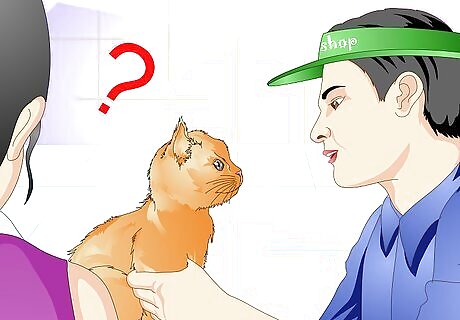
Ask the breeder or pet store worker if the cat is splayed. If you are buying the cat from a breeder or from a pet store, the breeder or the pet store worker should be able to tell you if the cat has been spayed. It is more difficult to get information on a cat from a shelter or a stray, so take the cat to the vet to confirm if you are not sure.
Recognizing the Signs of Heat (Estrus)
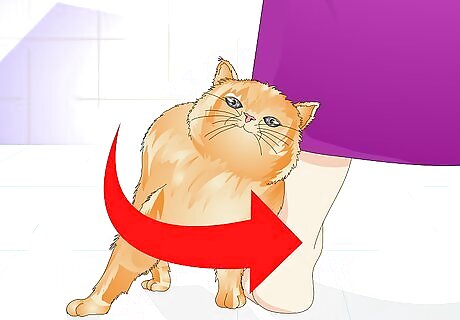
Note if the cat is overly affectionate or rubs up against you often. Cats who aren't spayed will periodically go into a period of heightened sexual activity called "heat", referred to scientifically as "estrus." This period of heat can last as long as three weeks, though visible symptoms usually don't last this long. A cat in heat will often act very affectionate, rubbing herself against people and inanimate objects and rolling around in a playful frenzy.
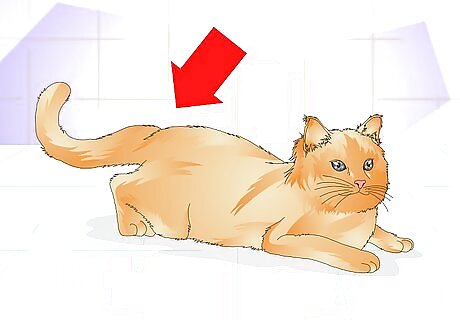
Check if the cat gets into the “presenting” stance or treads with her back legs. A cat in heat will often show sexual affection by getting into a "presenting" stance, or a crouching body position — her rear will be elevated, her tail will be raised or placed at one side, and her head will be held low to the ground. This is especially common in the presence of male cats. When a female cat goes into the crouching position, she will likely also tread or paddle with her back feet. She will lift each back foot quickly, like she is walking in place. This is thought to attract males during heat because this causes the female cat’s genitals to jiggle up and down as she walks.
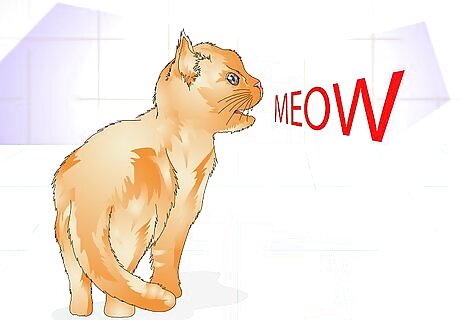
Listen for any yowling or loud meowing from the cat. A cat in heat will let out loud, yowling meows and other bleating noises. These vocalizations will typically start just after the onset of heat and grow in intensity over time. At their worst, these calls may be very frequent and may even sound pained or distressed, though the cat is not in any real danger. Other, less-common calls may range from quieter, inquiring mews to agitated screeches.
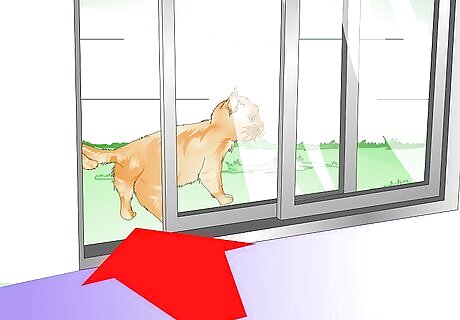
Check if the cat wants to spend more time outdoors. An indoor cat who goes into heat may suddenly adopt the habits of an outdoor cat. Cats in heat will often want to get outside so they can find a mate and may resort to behaviors like pawing and scratching at the door, making noises at the door, or even trying to dart outside as soon as the door is open. Keep a close eye on the cat whenever you enter or leave the house. If your cat escapes from the house, she may come home pregnant as she is not spayed.

Watch for any urine marking behavior from the cat. A cat who is not spayed will use her urine to let potential mates know when she is in heat. Urine marking is a common reproductive trait in female cats and can be prevented by getting the cat spayed. The cat may urine mark indoors or outdoors, especially in the presence of male cats.
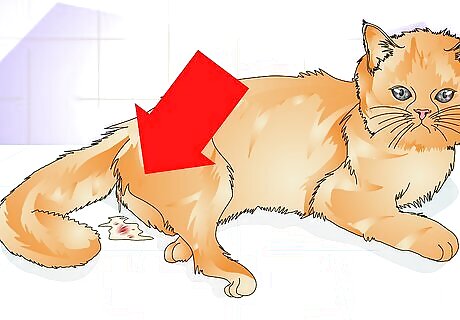
Note any vaginal discharge from the cat. Female cats who are not spayed may also have a small amount of vaginal discharge that is clear and watery or tinged with blood during heat. You may notice this discharge after the cat has been in heat for awhile. She will likely get into the “presenting” stance and tread before she starts to release the discharge. A cat should be taken to a veterinarian if there is a profuse discharge, as this indicates a womb infection.




















Comments
0 comment